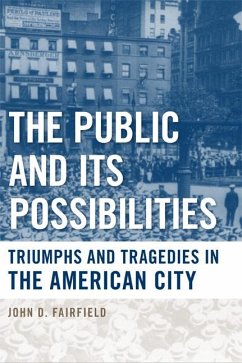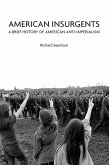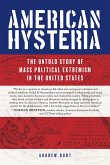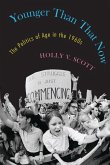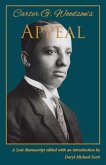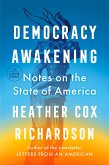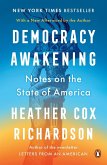John D. Fairfield
The Public and Its Possibilities: Triumphs and Tragedies in the American City
John D. Fairfield
The Public and Its Possibilities: Triumphs and Tragedies in the American City
- Broschiertes Buch
- Merkliste
- Auf die Merkliste
- Bewerten Bewerten
- Teilen
- Produkt teilen
- Produkterinnerung
- Produkterinnerung
John D. Fairfield is Professor of History and Academic Director of the Institute for Politics and Public Life at Xavier University and the author of The Mysteries of the Great City: The Politics of Urban Design, 1877-1937 .
Andere Kunden interessierten sich auch für
![American Insurgents American Insurgents]() Richard SeymourAmerican Insurgents17,99 €
Richard SeymourAmerican Insurgents17,99 €![American Hysteria: The Untold Story of Mass Political Extremism in the United States American Hysteria: The Untold Story of Mass Political Extremism in the United States]() Andrew BurtAmerican Hysteria: The Untold Story of Mass Political Extremism in the United States17,99 €
Andrew BurtAmerican Hysteria: The Untold Story of Mass Political Extremism in the United States17,99 €![Younger Than That Now: The Politics of Age in the 1960s Younger Than That Now: The Politics of Age in the 1960s]() Holly V. ScottYounger Than That Now: The Politics of Age in the 1960s33,99 €
Holly V. ScottYounger Than That Now: The Politics of Age in the 1960s33,99 €![Carter G. Woodson's Appeal Carter G. Woodson's Appeal]() Carter Godwin WoodsonCarter G. Woodson's Appeal38,99 €
Carter Godwin WoodsonCarter G. Woodson's Appeal38,99 €![Democracy Awakening Democracy Awakening]() Heather Cox RichardsonDemocracy Awakening27,99 €
Heather Cox RichardsonDemocracy Awakening27,99 €![Democracy Awakening Democracy Awakening]() Heather Cox RichardsonDemocracy Awakening13,76 €
Heather Cox RichardsonDemocracy Awakening13,76 €![Grassroots Girl A Conservative Activist's American Journey Grassroots Girl A Conservative Activist's American Journey]() Mary Kaye SorianoGrassroots Girl A Conservative Activist's American Journey18,99 €
Mary Kaye SorianoGrassroots Girl A Conservative Activist's American Journey18,99 €-
-
-
John D. Fairfield is Professor of History and Academic Director of the Institute for Politics and Public Life at Xavier University and the author of The Mysteries of the Great City: The Politics of Urban Design, 1877-1937 .
Hinweis: Dieser Artikel kann nur an eine deutsche Lieferadresse ausgeliefert werden.
Hinweis: Dieser Artikel kann nur an eine deutsche Lieferadresse ausgeliefert werden.
Produktdetails
- Produktdetails
- Urban Life, Landscape and Poli
- Verlag: Temple University Press
- Seitenzahl: 368
- Erscheinungstermin: Februar 2012
- Englisch
- Abmessung: 229mm x 152mm x 23mm
- Gewicht: 499g
- ISBN-13: 9781439902110
- ISBN-10: 1439902119
- Artikelnr.: 34199208
- Urban Life, Landscape and Poli
- Verlag: Temple University Press
- Seitenzahl: 368
- Erscheinungstermin: Februar 2012
- Englisch
- Abmessung: 229mm x 152mm x 23mm
- Gewicht: 499g
- ISBN-13: 9781439902110
- ISBN-10: 1439902119
- Artikelnr.: 34199208
John D. Fairfield is Professor of History and Academic Director of the Institute for Politics and Public Life at Xavier University and the author of The Mysteries of the Great City: The Politics of Urban Design, 1877-1937 .
Preface: The Public and Its Possibilities
Introduction: Liberalism and the Civic Strand in the American Past
Civic Aspirations and Liberal Values
An Urban Thesis
Part I. Civic Aspirations and Market Development in a Long Age of
Revolution
1.Democratizing the Republican Ideal of Citizenship: Virtue, Interests, and
the Citizen-Proprietor in the Revolutionary Era
Seaport Cities: Crucibles of Market and Public
The People Out of Doors and the Imperial Crisis
A More Democratic Public: Consumer Boycotts Politicize the Household
The Threat of Enslavement and the Need for Virtue: The Unifying Myth of the
American Revolution
Virtue and Vice in an Overheated Market
Redeeming the Revolution: Virtues or Mechanisms?
Citizen-Proprietors and the Democratization of Competence
Revolutionary Legacies, Democratic Futures
2. Creating Citizens in a Commercial Republic: Market 33 Transformation and
the Free Labor Ideal, 1812–1873
The Origins of the Free Labor Ideal
The Market Revolution and the Public Purpose
Labor Politics in the Jacksonian City: Unjust Government and a Conspiracy
to Enslave
A Crippled Democracy: Jacksonian Fears and Whig Paternalism
The Free Labor Ideology and the Transformation of Northern Whiggery
Positive Liberty: Turning Slaves into Citizens
The Limits of Radical Republicanism
3. The Short, Strange Career of Laissez-Faire: Liberal Reformers and
Genteel Culture in the Gilded Age
Big Business and Small Politics in the Gilded Age
Liberal Reformers and Genteel Culture
The Liberal Reformers’ Encounter with the City
Civic Murder: Liberal Reformers and Public Opinion
“This Word Culture”: An Industrial Tragedy at Pullman
Part II. Popular Culture, Political Culture: Building a Democratic Public
4. The Democratic Public in City and Nation: The Jacksonian City and the
Limits of Antislavery
Constructing a Public Realm
In the Streets: Law and the Public Realm
To the Park: The Strengths and Weaknesses of the Jacksonian Public
Popular Culture, Political Culture
Young America and Democratic Culture
The Republic of the Streets and Fields
The Astor Place Riot
Fatal Flaw: Young America and Negrophobia
Cultural Laissez-Faire versus the Evangelical United Front
Antislavery: Passion and Rationality in the Antebellum Public
Lincoln’s Rhetorical Revolution
5. The Democratic Public Discredited: The New York City Draft Riots and
Urban Reconstruction, 1850–1872
“The Most Radical City in America”
Nativism and the Erosion of Municipal Autonomy
The New York City Draft Riots
Draconian Justice: Reconstructing New York City
The Spectacular Rise and Precipitous Fall of Boss Tweed
Postwar Republicanism: Labor Revolt and Metropolitan Capital
Retrenchment and Reform
6. Cultural Hierarchy and Good Government: The Democratic Public in Eclipse
Highbrow/Lowbrow and an Incompetent Citizenry
Don’t Get Out the Vote
Municipal Counterrevolution: Dillon’s Rule and the Benevolent Expert
Domesticating the City
Civic Vertigo: The City Biological and Pathological
The Degeneration of Popular Politics
Mob Mind, Befuddled Public
Part III. The Public in Progressivism and War
7. The Republican Moment: The Rediscovery of the Public in the Progressive
Era
The City Beautiful and Intelligent
The Georgists and the City Republic
Democracy as Cooperative Inquiry: The Social Centers Movement
Mass Media and the Socialization of Intelligence
Nickel Madness or the Academy of the Working Man?
The National Board of Review of Motion Pictures and the Mutual Decision
The Rise of Hollywood and the Incorporation of Movie Culture
8. The Public Goes to War but Does Not Come Back: Requiem for a
Participatory Democracy
The War Intellectuals and The New Republic
The War for the American Mind
From Mastery to Drift
Trusting the Public Too Much or Too Little?
A Democrat on the Defensive
Participatory Democracy and Urban Culture: From Public Opinion to Public
Relations
Part IV. A Democracy of Consumers
9. From Economic Democracy to Social Security: The Labor Movement and the
Rise of the Welfare/Warfare State
Industrial Democracy, Industrial Discipline
The Syndicalist Moment
From the New Freedom to the New Nationalism: War and the Triumph of the
Corporate State
Labor’s War
From Welfare Capitalism to Moral Capitalism
Democratic Unions, Labor Party
The Second New Deal: Consumerist Democracy and the End of Antimonopoly
From New Deal to New War: Liberals and Labor Abandon Reform
Taming Labor in the Welfare/Warfare State
10. Constructing a Consumer Culture: Redirecting Leisure from Civic
Engagement to Insatiable Desire
The Popular Demand for Leisure and the Rise of the Saloon
The Leisure Question and Cheap Amusements
The Discovery of Play
Captains of Consciousness, Land of Desire
Exit the Saloon, Enter the Bijou
Shaping Character, Inculcating Values
The Incorporation of the Consumer Culture
Mass Culture, Mass Media, and the Consumerization of Politics
11. Private Vision, Public Resources: Mass Suburbanization and the Decline
of the City
New Deal Urban Policy and the Suburban-Industrial Complex
The Origins of the Urban Crisis I: Eroding the Tax and Employment Base
The Origins of the Urban Crisis II: Homeowner Pop u lism and the
Fragmentation of Metropolitan Government
Central City Housing: The Racial Time Bomb
Dispossession: Urban Redevelopment and Urban Renewal
Confronting the Reverse Welfare State: From Civil Rights to Black Power
Two Societies, Separate and Unequal
Suburban Secession and Farewell to the Public Realm
Conclusion: The Future of the City: >
The Great Unfinished Tasks of American Civilization
Private City, Public Crisis
Visions of Fear and Hope
Toward an Ecology of the City
Acknowledgments
Notes
Index
Introduction: Liberalism and the Civic Strand in the American Past
Civic Aspirations and Liberal Values
An Urban Thesis
Part I. Civic Aspirations and Market Development in a Long Age of
Revolution
1.Democratizing the Republican Ideal of Citizenship: Virtue, Interests, and
the Citizen-Proprietor in the Revolutionary Era
Seaport Cities: Crucibles of Market and Public
The People Out of Doors and the Imperial Crisis
A More Democratic Public: Consumer Boycotts Politicize the Household
The Threat of Enslavement and the Need for Virtue: The Unifying Myth of the
American Revolution
Virtue and Vice in an Overheated Market
Redeeming the Revolution: Virtues or Mechanisms?
Citizen-Proprietors and the Democratization of Competence
Revolutionary Legacies, Democratic Futures
2. Creating Citizens in a Commercial Republic: Market 33 Transformation and
the Free Labor Ideal, 1812–1873
The Origins of the Free Labor Ideal
The Market Revolution and the Public Purpose
Labor Politics in the Jacksonian City: Unjust Government and a Conspiracy
to Enslave
A Crippled Democracy: Jacksonian Fears and Whig Paternalism
The Free Labor Ideology and the Transformation of Northern Whiggery
Positive Liberty: Turning Slaves into Citizens
The Limits of Radical Republicanism
3. The Short, Strange Career of Laissez-Faire: Liberal Reformers and
Genteel Culture in the Gilded Age
Big Business and Small Politics in the Gilded Age
Liberal Reformers and Genteel Culture
The Liberal Reformers’ Encounter with the City
Civic Murder: Liberal Reformers and Public Opinion
“This Word Culture”: An Industrial Tragedy at Pullman
Part II. Popular Culture, Political Culture: Building a Democratic Public
4. The Democratic Public in City and Nation: The Jacksonian City and the
Limits of Antislavery
Constructing a Public Realm
In the Streets: Law and the Public Realm
To the Park: The Strengths and Weaknesses of the Jacksonian Public
Popular Culture, Political Culture
Young America and Democratic Culture
The Republic of the Streets and Fields
The Astor Place Riot
Fatal Flaw: Young America and Negrophobia
Cultural Laissez-Faire versus the Evangelical United Front
Antislavery: Passion and Rationality in the Antebellum Public
Lincoln’s Rhetorical Revolution
5. The Democratic Public Discredited: The New York City Draft Riots and
Urban Reconstruction, 1850–1872
“The Most Radical City in America”
Nativism and the Erosion of Municipal Autonomy
The New York City Draft Riots
Draconian Justice: Reconstructing New York City
The Spectacular Rise and Precipitous Fall of Boss Tweed
Postwar Republicanism: Labor Revolt and Metropolitan Capital
Retrenchment and Reform
6. Cultural Hierarchy and Good Government: The Democratic Public in Eclipse
Highbrow/Lowbrow and an Incompetent Citizenry
Don’t Get Out the Vote
Municipal Counterrevolution: Dillon’s Rule and the Benevolent Expert
Domesticating the City
Civic Vertigo: The City Biological and Pathological
The Degeneration of Popular Politics
Mob Mind, Befuddled Public
Part III. The Public in Progressivism and War
7. The Republican Moment: The Rediscovery of the Public in the Progressive
Era
The City Beautiful and Intelligent
The Georgists and the City Republic
Democracy as Cooperative Inquiry: The Social Centers Movement
Mass Media and the Socialization of Intelligence
Nickel Madness or the Academy of the Working Man?
The National Board of Review of Motion Pictures and the Mutual Decision
The Rise of Hollywood and the Incorporation of Movie Culture
8. The Public Goes to War but Does Not Come Back: Requiem for a
Participatory Democracy
The War Intellectuals and The New Republic
The War for the American Mind
From Mastery to Drift
Trusting the Public Too Much or Too Little?
A Democrat on the Defensive
Participatory Democracy and Urban Culture: From Public Opinion to Public
Relations
Part IV. A Democracy of Consumers
9. From Economic Democracy to Social Security: The Labor Movement and the
Rise of the Welfare/Warfare State
Industrial Democracy, Industrial Discipline
The Syndicalist Moment
From the New Freedom to the New Nationalism: War and the Triumph of the
Corporate State
Labor’s War
From Welfare Capitalism to Moral Capitalism
Democratic Unions, Labor Party
The Second New Deal: Consumerist Democracy and the End of Antimonopoly
From New Deal to New War: Liberals and Labor Abandon Reform
Taming Labor in the Welfare/Warfare State
10. Constructing a Consumer Culture: Redirecting Leisure from Civic
Engagement to Insatiable Desire
The Popular Demand for Leisure and the Rise of the Saloon
The Leisure Question and Cheap Amusements
The Discovery of Play
Captains of Consciousness, Land of Desire
Exit the Saloon, Enter the Bijou
Shaping Character, Inculcating Values
The Incorporation of the Consumer Culture
Mass Culture, Mass Media, and the Consumerization of Politics
11. Private Vision, Public Resources: Mass Suburbanization and the Decline
of the City
New Deal Urban Policy and the Suburban-Industrial Complex
The Origins of the Urban Crisis I: Eroding the Tax and Employment Base
The Origins of the Urban Crisis II: Homeowner Pop u lism and the
Fragmentation of Metropolitan Government
Central City Housing: The Racial Time Bomb
Dispossession: Urban Redevelopment and Urban Renewal
Confronting the Reverse Welfare State: From Civil Rights to Black Power
Two Societies, Separate and Unequal
Suburban Secession and Farewell to the Public Realm
Conclusion: The Future of the City: >
The Great Unfinished Tasks of American Civilization
Private City, Public Crisis
Visions of Fear and Hope
Toward an Ecology of the City
Acknowledgments
Notes
Index
Preface: The Public and Its Possibilities
Introduction: Liberalism and the Civic Strand in the American Past
Civic Aspirations and Liberal Values
An Urban Thesis
Part I. Civic Aspirations and Market Development in a Long Age of
Revolution
1.Democratizing the Republican Ideal of Citizenship: Virtue, Interests, and
the Citizen-Proprietor in the Revolutionary Era
Seaport Cities: Crucibles of Market and Public
The People Out of Doors and the Imperial Crisis
A More Democratic Public: Consumer Boycotts Politicize the Household
The Threat of Enslavement and the Need for Virtue: The Unifying Myth of the
American Revolution
Virtue and Vice in an Overheated Market
Redeeming the Revolution: Virtues or Mechanisms?
Citizen-Proprietors and the Democratization of Competence
Revolutionary Legacies, Democratic Futures
2. Creating Citizens in a Commercial Republic: Market 33 Transformation and
the Free Labor Ideal, 1812–1873
The Origins of the Free Labor Ideal
The Market Revolution and the Public Purpose
Labor Politics in the Jacksonian City: Unjust Government and a Conspiracy
to Enslave
A Crippled Democracy: Jacksonian Fears and Whig Paternalism
The Free Labor Ideology and the Transformation of Northern Whiggery
Positive Liberty: Turning Slaves into Citizens
The Limits of Radical Republicanism
3. The Short, Strange Career of Laissez-Faire: Liberal Reformers and
Genteel Culture in the Gilded Age
Big Business and Small Politics in the Gilded Age
Liberal Reformers and Genteel Culture
The Liberal Reformers’ Encounter with the City
Civic Murder: Liberal Reformers and Public Opinion
“This Word Culture”: An Industrial Tragedy at Pullman
Part II. Popular Culture, Political Culture: Building a Democratic Public
4. The Democratic Public in City and Nation: The Jacksonian City and the
Limits of Antislavery
Constructing a Public Realm
In the Streets: Law and the Public Realm
To the Park: The Strengths and Weaknesses of the Jacksonian Public
Popular Culture, Political Culture
Young America and Democratic Culture
The Republic of the Streets and Fields
The Astor Place Riot
Fatal Flaw: Young America and Negrophobia
Cultural Laissez-Faire versus the Evangelical United Front
Antislavery: Passion and Rationality in the Antebellum Public
Lincoln’s Rhetorical Revolution
5. The Democratic Public Discredited: The New York City Draft Riots and
Urban Reconstruction, 1850–1872
“The Most Radical City in America”
Nativism and the Erosion of Municipal Autonomy
The New York City Draft Riots
Draconian Justice: Reconstructing New York City
The Spectacular Rise and Precipitous Fall of Boss Tweed
Postwar Republicanism: Labor Revolt and Metropolitan Capital
Retrenchment and Reform
6. Cultural Hierarchy and Good Government: The Democratic Public in Eclipse
Highbrow/Lowbrow and an Incompetent Citizenry
Don’t Get Out the Vote
Municipal Counterrevolution: Dillon’s Rule and the Benevolent Expert
Domesticating the City
Civic Vertigo: The City Biological and Pathological
The Degeneration of Popular Politics
Mob Mind, Befuddled Public
Part III. The Public in Progressivism and War
7. The Republican Moment: The Rediscovery of the Public in the Progressive
Era
The City Beautiful and Intelligent
The Georgists and the City Republic
Democracy as Cooperative Inquiry: The Social Centers Movement
Mass Media and the Socialization of Intelligence
Nickel Madness or the Academy of the Working Man?
The National Board of Review of Motion Pictures and the Mutual Decision
The Rise of Hollywood and the Incorporation of Movie Culture
8. The Public Goes to War but Does Not Come Back: Requiem for a
Participatory Democracy
The War Intellectuals and The New Republic
The War for the American Mind
From Mastery to Drift
Trusting the Public Too Much or Too Little?
A Democrat on the Defensive
Participatory Democracy and Urban Culture: From Public Opinion to Public
Relations
Part IV. A Democracy of Consumers
9. From Economic Democracy to Social Security: The Labor Movement and the
Rise of the Welfare/Warfare State
Industrial Democracy, Industrial Discipline
The Syndicalist Moment
From the New Freedom to the New Nationalism: War and the Triumph of the
Corporate State
Labor’s War
From Welfare Capitalism to Moral Capitalism
Democratic Unions, Labor Party
The Second New Deal: Consumerist Democracy and the End of Antimonopoly
From New Deal to New War: Liberals and Labor Abandon Reform
Taming Labor in the Welfare/Warfare State
10. Constructing a Consumer Culture: Redirecting Leisure from Civic
Engagement to Insatiable Desire
The Popular Demand for Leisure and the Rise of the Saloon
The Leisure Question and Cheap Amusements
The Discovery of Play
Captains of Consciousness, Land of Desire
Exit the Saloon, Enter the Bijou
Shaping Character, Inculcating Values
The Incorporation of the Consumer Culture
Mass Culture, Mass Media, and the Consumerization of Politics
11. Private Vision, Public Resources: Mass Suburbanization and the Decline
of the City
New Deal Urban Policy and the Suburban-Industrial Complex
The Origins of the Urban Crisis I: Eroding the Tax and Employment Base
The Origins of the Urban Crisis II: Homeowner Pop u lism and the
Fragmentation of Metropolitan Government
Central City Housing: The Racial Time Bomb
Dispossession: Urban Redevelopment and Urban Renewal
Confronting the Reverse Welfare State: From Civil Rights to Black Power
Two Societies, Separate and Unequal
Suburban Secession and Farewell to the Public Realm
Conclusion: The Future of the City: >
The Great Unfinished Tasks of American Civilization
Private City, Public Crisis
Visions of Fear and Hope
Toward an Ecology of the City
Acknowledgments
Notes
Index
Introduction: Liberalism and the Civic Strand in the American Past
Civic Aspirations and Liberal Values
An Urban Thesis
Part I. Civic Aspirations and Market Development in a Long Age of
Revolution
1.Democratizing the Republican Ideal of Citizenship: Virtue, Interests, and
the Citizen-Proprietor in the Revolutionary Era
Seaport Cities: Crucibles of Market and Public
The People Out of Doors and the Imperial Crisis
A More Democratic Public: Consumer Boycotts Politicize the Household
The Threat of Enslavement and the Need for Virtue: The Unifying Myth of the
American Revolution
Virtue and Vice in an Overheated Market
Redeeming the Revolution: Virtues or Mechanisms?
Citizen-Proprietors and the Democratization of Competence
Revolutionary Legacies, Democratic Futures
2. Creating Citizens in a Commercial Republic: Market 33 Transformation and
the Free Labor Ideal, 1812–1873
The Origins of the Free Labor Ideal
The Market Revolution and the Public Purpose
Labor Politics in the Jacksonian City: Unjust Government and a Conspiracy
to Enslave
A Crippled Democracy: Jacksonian Fears and Whig Paternalism
The Free Labor Ideology and the Transformation of Northern Whiggery
Positive Liberty: Turning Slaves into Citizens
The Limits of Radical Republicanism
3. The Short, Strange Career of Laissez-Faire: Liberal Reformers and
Genteel Culture in the Gilded Age
Big Business and Small Politics in the Gilded Age
Liberal Reformers and Genteel Culture
The Liberal Reformers’ Encounter with the City
Civic Murder: Liberal Reformers and Public Opinion
“This Word Culture”: An Industrial Tragedy at Pullman
Part II. Popular Culture, Political Culture: Building a Democratic Public
4. The Democratic Public in City and Nation: The Jacksonian City and the
Limits of Antislavery
Constructing a Public Realm
In the Streets: Law and the Public Realm
To the Park: The Strengths and Weaknesses of the Jacksonian Public
Popular Culture, Political Culture
Young America and Democratic Culture
The Republic of the Streets and Fields
The Astor Place Riot
Fatal Flaw: Young America and Negrophobia
Cultural Laissez-Faire versus the Evangelical United Front
Antislavery: Passion and Rationality in the Antebellum Public
Lincoln’s Rhetorical Revolution
5. The Democratic Public Discredited: The New York City Draft Riots and
Urban Reconstruction, 1850–1872
“The Most Radical City in America”
Nativism and the Erosion of Municipal Autonomy
The New York City Draft Riots
Draconian Justice: Reconstructing New York City
The Spectacular Rise and Precipitous Fall of Boss Tweed
Postwar Republicanism: Labor Revolt and Metropolitan Capital
Retrenchment and Reform
6. Cultural Hierarchy and Good Government: The Democratic Public in Eclipse
Highbrow/Lowbrow and an Incompetent Citizenry
Don’t Get Out the Vote
Municipal Counterrevolution: Dillon’s Rule and the Benevolent Expert
Domesticating the City
Civic Vertigo: The City Biological and Pathological
The Degeneration of Popular Politics
Mob Mind, Befuddled Public
Part III. The Public in Progressivism and War
7. The Republican Moment: The Rediscovery of the Public in the Progressive
Era
The City Beautiful and Intelligent
The Georgists and the City Republic
Democracy as Cooperative Inquiry: The Social Centers Movement
Mass Media and the Socialization of Intelligence
Nickel Madness or the Academy of the Working Man?
The National Board of Review of Motion Pictures and the Mutual Decision
The Rise of Hollywood and the Incorporation of Movie Culture
8. The Public Goes to War but Does Not Come Back: Requiem for a
Participatory Democracy
The War Intellectuals and The New Republic
The War for the American Mind
From Mastery to Drift
Trusting the Public Too Much or Too Little?
A Democrat on the Defensive
Participatory Democracy and Urban Culture: From Public Opinion to Public
Relations
Part IV. A Democracy of Consumers
9. From Economic Democracy to Social Security: The Labor Movement and the
Rise of the Welfare/Warfare State
Industrial Democracy, Industrial Discipline
The Syndicalist Moment
From the New Freedom to the New Nationalism: War and the Triumph of the
Corporate State
Labor’s War
From Welfare Capitalism to Moral Capitalism
Democratic Unions, Labor Party
The Second New Deal: Consumerist Democracy and the End of Antimonopoly
From New Deal to New War: Liberals and Labor Abandon Reform
Taming Labor in the Welfare/Warfare State
10. Constructing a Consumer Culture: Redirecting Leisure from Civic
Engagement to Insatiable Desire
The Popular Demand for Leisure and the Rise of the Saloon
The Leisure Question and Cheap Amusements
The Discovery of Play
Captains of Consciousness, Land of Desire
Exit the Saloon, Enter the Bijou
Shaping Character, Inculcating Values
The Incorporation of the Consumer Culture
Mass Culture, Mass Media, and the Consumerization of Politics
11. Private Vision, Public Resources: Mass Suburbanization and the Decline
of the City
New Deal Urban Policy and the Suburban-Industrial Complex
The Origins of the Urban Crisis I: Eroding the Tax and Employment Base
The Origins of the Urban Crisis II: Homeowner Pop u lism and the
Fragmentation of Metropolitan Government
Central City Housing: The Racial Time Bomb
Dispossession: Urban Redevelopment and Urban Renewal
Confronting the Reverse Welfare State: From Civil Rights to Black Power
Two Societies, Separate and Unequal
Suburban Secession and Farewell to the Public Realm
Conclusion: The Future of the City: >
The Great Unfinished Tasks of American Civilization
Private City, Public Crisis
Visions of Fear and Hope
Toward an Ecology of the City
Acknowledgments
Notes
Index
